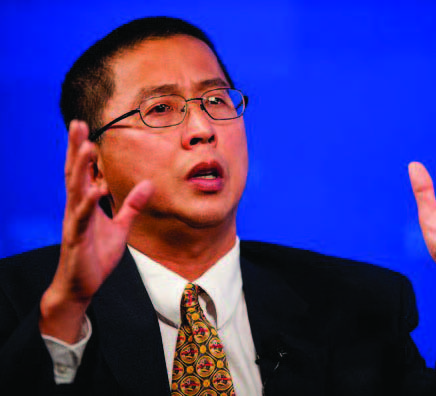
Dr. Willie [Wei-Hock] Soon is a world renowned Climate Realist who has published dozens of papers demonstrating solar activity to be the overwhelmingly largest driver of climate change. Currently employed at the Harvard-Smithsonian Center for Astrophysics and a receiving editor of the Journal of New Astronomy, Soon has also been an astronomer at the Mount Wilson Observatory since 1992.
Willie Soon, Ph.D., is an astrophysicist in the Solar, Stellar and Planetary Sciences Division of the Harvard- Smithsonian Center for Astrophysics in Cambridge, Massachusetts.
Soon’s career has proven to be a textbook example of speaking truth to power and bravely facing the consequences.
Beginning in 1994, Soon produced an important series of astrophysics papers on the Sun’s impact on Earth’s climate, which received positive discussion in the U.N. Intergovernmental Panel on Climate Change’s (IPCC) second and third assessment reports, released in 1996 and 2001, respectively.
Throughout the 1990s, IPCC still acknowledged there were uncertainties about humankind’s potential influence on climate, despite pressure from nongovernmental organizations to find a “smoking gun” in the weak data.
In his 2007 book History of the Science and Politics of Climate Change, Bert Bolin, cocreator and first chairman of IPCC, deplored the denial of uncertainty, writing, “It was nongovernmental groups of environmentalists, supported by the mass media who were the ones exaggerating the conclusions that had been carefully formulated by the IPCC.”
In 1997, Bolin told the Associated Press, “Global warming is not something you can ‘prove.’You try to collect evidence and thereby a picture emerges.” Soon’s study about the influence of the Sun on climate made him a target for alarmists, but Soon had defenders. In a 2013, Boston Globe article, iconic physicist Freeman Dyson praised Soon. “The whole point of science is to question accepted dogmas,” said Dyson. “For that reason, I respect Willie Soon as a good scientist and a courageous citizen.”
Unjustified ‘Conflict of Interest’ Claims
In February 2015, Greenpeace agent Kert Davies, a vocal critic of Soon since 1997, falsely accused him of wrongfully failing to disclose “conflicts of interest” to an academic journal he submitted research to. Despite the fact the journal’s editors and the Smithsonian Institution found no violation of their disclosure or conflict of interest rules, Davies’ accusation created a clamor amongst alarmist reporters, who repeated the claim without further investigation.
The Greenpeace ruckus brought pressure from the Obama administration on the Harvard- Smithsonian Center to silence climate skeptics.
Smithsonian responded with an elaborate new “Directive on Standards of Conduct,” which forced its employees to wade through bureaucratic rules replete with an ethics counselor and a “Loyalty to the Smithsonian” clause.
Despite the pressure applied to Smithsonian, its inspector general found Soon had not broken any rules, prompting additional attacks from alarmists.
In March and April 2016, two outlets published stories scurrilously demonizing Soon, relying heavily on bogus claims. The two activistwriters, David Hasemyer, who worked for the controversial InsideClimateNews, and Paul Basken, who worked for The Chronicle of Higher Education, seem to have forgotten journalistic ethics and the facts.
Multiple Checks Prevent Biased Research
Neither Hasemyer nor Basken displayed any familiarity with the hurdles scientists have to clear in order to do science in the Harvard- Smithsonian Center for Astrophysics.
About one-third of the Center’s scientists, including Soon, are employed in what are called “Smithsonian Trust positions.” These positions are held mostly by Ph.D. specialists. According to the Smithsonian Employee Handbook, paychecks given to those holding federal positions are paid from Smithsonian’s annual federal appropriation, while Trust positions are paid from Smithsonian’s trust fund. Trust scientists are paid by the hour. According to Smithsonian’s requirements, scientists in Trust positions develop donors willing to give Smithsonian grants to fund research. “Obtaining competitive funding is an important part of the scientists’ jobs and a measure of their career success,” states the Smithsonian Employee Handbook.
Grants go directly to Smithsonian for the specified science projects, and 30–40 percent of each grant goes directly to Smithsonian for management and overhead costs. The money never goes directly to the researcher. Media attacks made against Soon for his fundraising prowess, which is part of his duty as a Smithsonian employee, are either ignorant or disingenuous. Trust scientists must follow exacting procedures established in Smithsonian’s contractual terms and the detailed “Contract and Grant Administration” rules in order to obtain grants.
One prescribed step requires each researcher to prepare a draft of any proposed scientific project to be pre-approved by the director of the Harvard-Smithsonian Center for Astrophysics. The scientists must give the director suggestions for potential funders, but all decisions remain in the hands of the director.
If the director approves the draft proposal, he signs it and gives it to the Grant Office, which prepares the presentation package, including a budget, the approved proposal, and a cover letter formally requesting a grant. After the director signs the cover letter, the grant officer sends it to the potential donor.
Donors can agree to be invoiced by the Harvard-Smithsonian Center for Astrophysics, or they can make a direct payment to Smithsonian, which handles all of the Center’s money. The scientist who performs the project may not even know who gave the grant funding for his or her research. Even unfunded studies produced by Smithsonian researchers for peerreviewed journals have to follow Smithsonian procedures and gain the appropriate approvals.
With Smithsonian’s safeguards in place and publicly available, hostile reports attacking Soon cannot be considered ethical journalism according to the “Code of Ethics” of the Society of Professional Journalists, which states: “Ethical journalism should be accurate and fair. Journalists should examine the ways their values and experiences may shape their reporting. Journalists should support the open and civil exchange of views, even views they find repugnant.”
Accordingly, writers who’ve accused Soon of wrongdoing despite evidence to the contrary are unethical and should be censured.
